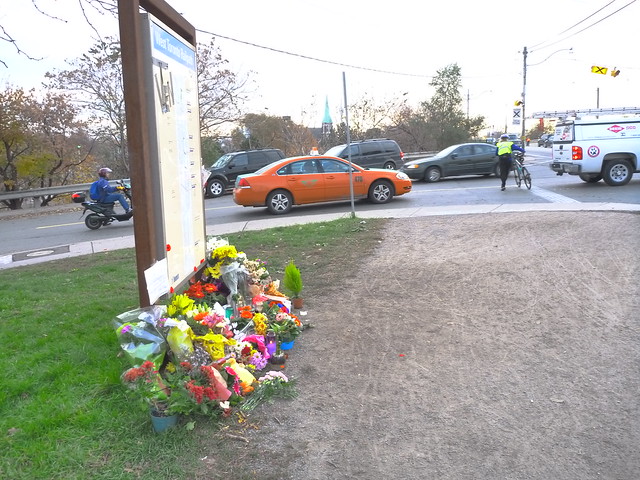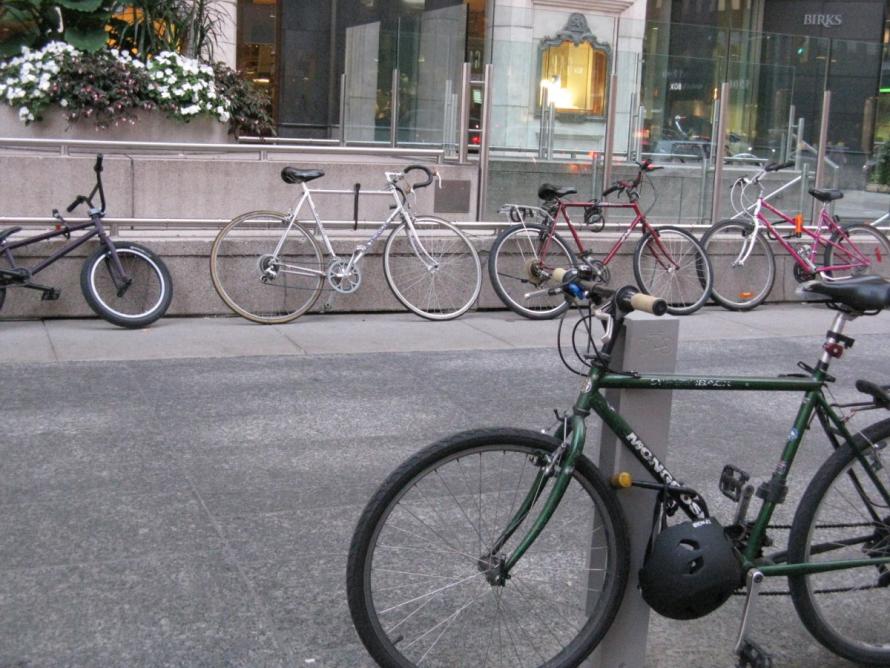In the wake of the death of Jenna Morrison because of a large truck on a dangerous stretch of Toronto road and the road rage incident where a male driver assaulted a woman with his car just because she was in front of him making a legal left turn, I'd like to reprint a op ed article by Heather McDonald responding to the decision by an all-male Public Works Committee to remove the Jarvis bike lanes, ignoring the voice of the vulnerable. Cycling infrastrucure, Heather points out, is a women's issue.
Every day on my way home from work, my last bit of the journey involves making a left hand turn onto my quiet street. I take a deep breath, check my shoulder, signal, and brace myself for my most loathed part of my trip. On several occasions, as I extended my arm and safely merged into the lane, I’ve been shouted at by a passing car driver. Twice I’ve been called the “C word”—just for turning the way they teach in a CanBike course. I come home near tears and lament to my partner how awful it feels to be treated so poorly just for using my bike for transportation. It’s downright insulting.
More insulting: we’re being shoved out from having a role in making the decisions that affect us.
A few years ago, when I was providing home care for patients, I found myself cycling up and down Jarvis frequently, visiting various community housing locations along the street. The traffic speeds were far over the limit. The noise was excessive. Even the residents avoided walking on Jarvis. One woman with anxiety discussed with me how she feared crossing Jarvis Street and avoided leaving her house to go to appointments. The streetscape design suggested that people in single-occupancy vehicles were worth more than people on bicycles.
What a difference two years and bike lanes make: cycling has increased from approximately 300 to 900 cyclists per day. Two weeks ago I stood watching cyclists pass for an hour. These are people who depend on the bike lane as a convenient way to get home safely.
Councillor John Parker (Ward 26, Don Valley West) introduced a motion at the recent Public Works and Infrastructure Committee to remove this exact bike lane—and he did so without notice, after hours of debate about cycling infrastructure, but not about Jarvis. This scenario perfectly illustrates a formula for shoving vulnerable people out of the process: ignore the numbers, and the people discussing them. Use the rhetoric of war to incite fear and intimidate people. Avoid any community consultation. And that female councillor whose ward you’re meddling in, with your mostly male executive committee? Don’t mind her.
Here’s another often-ignored element to this debate: cycling infrastructure is, among other things, a women’s issue.
I’ve been asked why I link my cycling advocacy to women’s issues—and at times I am hesitant to do so. But in the literature on safe streets, the number of women cycling is seen as an indicator of safety and convenience. Women take more short trips then men. They are more likely pick up children, run errands, or accompany elderly parents to appointments. In all these short trips women encounter the consequences of a transportation system that has been dominated by men for the past century. Every year 35 vulnerable road users (pedestrians and cyclists) die on our roads, many more are injured. Congestion and air quality are significant problems. Something is broken with our transportation system, and catering to the private automobile is not the solution. I think about this every time I hear females explain (more often than men) that they would love to be riding a bike if only the streets were safer. When the committee tasked with implementing cycling infrastructure is composed of six men who get to make decisions without public consultation, I can’t help but be struck by the injustice to these women riding on Jarvis.
I proudly support the dedicated women who are are working to advocate for better conditions for cyclists and pedestrians. My mentor in safe streets advocacy, now director of the Toronto Coalition for Active Transportation, Nancy Smith Lea, wrote about issues of inequity in public transportation ten years ago. Today a line from an article she wrote rings truer than ever. “Society, and in particular, women, have not been served well by the transportation tools and housing developments designed by men. Potentially powerful linkages to achieve social change exist between feminism and transportation.” [PDF]
I’m not naive. Cycling won’t solve all our problems, and cars aren’t going away. But if we have to fight like hell for each improvement in cycling infrastructure and are resisted or lied to at every step of the way, what hope do we have for any improvement that makes our city more livable? Streets need to safely accommodate all road users and provide safe, convenient places to travel for all members of our society.
More and more I find myself asking, how can we have productive conversations about the just and logical use of road space when even our own politicians see the people riding those bikes as disposable members of society? Doug Ford himself suggested that the alternative to taking an imaginary road was to knock off cyclists on Queen Street. I wrote him a letter about that and I’m still waiting to hear back.
I’ve got my arm out signalling my intention to move forward in a productive, solution-focused and evidence-based way. I’m signalling the way that many cities across the world are moving, and there are lots of Torontonians with me. We’ve got a tailwind fueled by a confluence of factors such as the obesity crisis, rising gas prices, concern over air quality, and most importantly, the joy that comes from the convenience of riding a bike. You can call me names, but you can’t ignore me.
Heather McDonald is an occupational therapist in the trauma unit of a downtown hospital by day. She moonlights as the president of the Toronto Cyclists Union.
There is a memorial for Jenna Morrison on Monday (tomorrow) at 7:30am starting Spadina and Bloor and ending at Sterling and Dundas.




